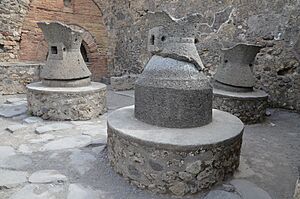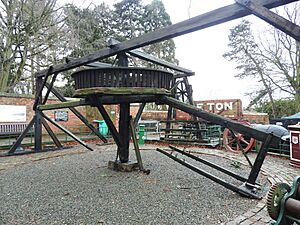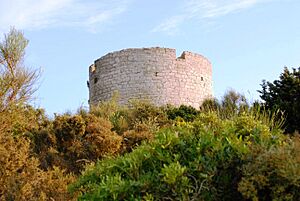Horse mill facts for kids

A horse mill is a special type of mill that uses the power of animals, usually horses, to make things work. Think of it like an old-fashioned engine! Instead of electricity or gas, it uses animals to turn wheels and grind grain or pump water. While horses were most common, other animals like donkeys, oxen, camels, and even dogs could power these mills. Humans could also power similar machines called treadwheels.
Contents
History of Horse Mills

The idea of using a donkey or horse to turn a mill in a circle started a long time ago. It was invented by the Carthaginians around 400 BC. They might have first developed it in Sardinia.
Evidence of these early mills was found in a shipwreck from around 375-350 BC near Mallorca. These mills used red lava stones from Sardinia. The idea then traveled to Sicily and reached Italy by the 3rd century BC.
Before animal-powered mills, people used hand-powered mills. But using horses and donkeys made the work much easier for millers. It also allowed them to grind a lot more grain because animals are stronger and can work longer than humans.
How Horse Mills Work: A Look at Beamish Museum
At the Beamish Museum, there's an old horse mill that hasn't been used since about 1830. It was saved from a farm and rebuilt at the museum. Even though it doesn't work now, it helps us understand how these amazing machines operated.
The main part of the mill is a tall, strong oak pole, about 10 feet (3 meters) high. This pole stands straight up in the middle of a special round building called a gin gang. The bottom of the pole spins on an iron frame on the floor. The top of the pole is held in place by a strong wooden beam above it, but it can still turn freely.
Building a Four-Horse Mill
This particular mill was designed for four horses. Near the top of the main pole, there's a large, flat gear wheel, about 6 feet (2 meters) across. This wheel has teeth on its top surface.
A huge oak pole, called the main drive shaft, connects to this big gear wheel. It has a smaller gear wheel that sits on top of the main one. As the main gear turns, it spins the drive shaft.
The drive shaft then goes through a hole in the wall into another building, often a threshing barn. Inside the barn, the drive shaft powers other machines like a threshing machine, which separates grain from stalks. It uses more gears and belts to transfer the power.
Horse Power in Action
This mill was very powerful, designed for four horses. These were probably English ponies, as the very large heavy horses we see today hadn't been fully developed by the 1830s.
Four long, heavy oak beams connect the central pole to where the horses would be attached. These beams support the large gear wheel and create a strong structure. They stick out quite far from the mill, and the horses would be harnessed to the ends of these beams. The low height of the harnesses suggests that smaller ponies were used.
Horse Gin at Nottingham Industrial Museum
A horse gin is another type of animal-powered machine, often used in coal mining. You can see one at the Nottingham Industrial Museum. This particular gin was built in 1841 to help dig a mine shaft. Later, it was moved to another mine and kept working until 1950!
At the mine, the horse gin was used to lift coal up from the ground. The Nottingham mines were not very deep. Coal was put onto a sled, which was then lifted in a cage. A rope attached to the cage would wind around a large drum, and horses walking in a circle would turn this drum.
Horse Gins in the Black Country
Horse 'gins' were very common in coal mining areas, especially where the coal was close to the surface. They were simple wooden machines with a central pole that a horse would pull around. This action would operate a pulley system to raise or lower loads in and out of the mine shaft.
These gins were often used in areas like Ruiton farm in the Black Country. They even played a role during the Miners' Strike of 1926, when some miners dug coal from shallow spots using simple "Bob Holes" and pulled it up with buckets. These activities eventually led to the start of Ellowes Colliery. The Earl of Dudley later allowed this mining to continue legally. The shallower coal was mined using these horse-powered 'gins'. Eventually, deeper shafts and steam-powered machines took over. The 'gin' at Ellowes Colliery was thought to be the last one still working in the Black Country when it closed in 1951.
Brewers' House Museum
In Antwerp, Belgium, there's a place called the Brewers' House museum. It shows how horse power was used to pump water. The building is from the 1500s. Even though the original wooden machinery was replaced with iron parts in the mid-1800s, the way it was set up is still the same.
Horse Mills Still in Use Today
Believe it or not, some horse mills are still used today! The Noah Hoover Mennonites, a group of people who don't use modern engine power, have several horse mills. You can find them in the US and in Belize in Central America.
These mills are used for different jobs. For example, in Scottsville, Kentucky, a horse mill helps juice sorghum cane. In Springfield and Pine Hill, Belize, horse mills are used to power sawmills, cutting wood for building.
Images for kids
-
A bullock-powered mill, Seychelles
-
The olive grinding mill, High Atlas (Morocco)
-
A horse-powered threshing machine.
The horse and harness nearest the viewer have been omitted to show the machinery. -
Drive shaft gear resting on main horizontal gear wheel which is attached to top of main vertical axle of mill
-
Main horizontal gear wheel at top of main axle, with drive shaft gear wheel on it. Drive shaft transfers power through threshing barn wall.
-
Horse shaft fixed to one of four long beams, all braced to each other with stretchers, and each fixed to the side of the top of the main axle.
See also
- The International Molinological Society
- Museum of Scottish Country Life
- Lambroughton Titwood Farm Horse Mill
- Donkey Stone
- Edge mill
- Experiment (horse powered boat)
- Gin gang
- Whim (mining)



















